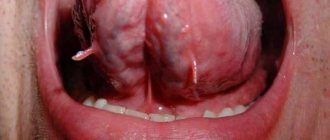The formation of various cysts, papillomas and other growths outside the body does not particularly surprise anyone. At the same time, such benign formations are not so much of a concern. It’s another matter when one of them forms inside, for example in the throat. There is already a reason for concern that is quite understandable - the formation is not visible, it creates discomfort, and in some cases, no, no, and a crazy thought will creep in: is it cancer?
What benign formations in the throat are, what they can be fraught with and how to deal with them, an otolaryngologist of the highest category, Ph.D., Vladimir Zaitsev .
Worrying about a cyst
“Some people are very afraid of cysts, believing that they are the same as cancer. Not everything is so simple here. Yes, one of the bad things that can be distinguished is that this is still a formation, which means that plus excess tissue means that something was not normal before, but has now appeared. The good thing is that such cysts rarely become malignant, that is, the chances that it will become cancer tend to zero,” notes the ENT specialist.
At the same time, Vladimir Zaitsev also says that against the background of such data, the cyst should not be ignored. “If you don’t treat the cyst, but come to terms with it and get used to it, then you can lead to polycystic disease, when yesterday there was one cyst, today there are two, and tomorrow a third will appear,” explains the doctor.
There should be no self-medication; there is a risk of worsening the situation with your own hands. For example, polycystic disease can develop even if a person himself decides to remove the formation. “If the cyst is removed incorrectly, for example, it is simply opened, as a result of which the cystic fluid comes out, but the membrane is preserved, then the following will happen: the membrane will collapse, the cyst will lose its tone, then it will stick into the tissue, a bridge will develop, and two cysts will appear in one place.” , notes the ENT. At the same time, you cannot climb into your throat either with improvised means or with small scalpels, which can be purchased at the same pharmacy.
Choking and skin problems. What are the consequences of the papilloma virus besides cancer? Read more
Cyst or papilloma?
Cysts are different. The most common is a formation in the palatine tonsil. “For example, a person has developed chronic tonsillitis, the tissues of the tonsils are affected, plugs form in the thickness of the palatine tonsils - you can quite see them yourself by opening your mouth wider and looking into it with a flashlight. They look like an accumulation of pus,” says Vladimir Zaitsev.
At the same time, people do not know what to do with such formations. Either you need to ignore them - they will go away on their own, or go to the doctor, or try to squeeze them out on your own. There are situations when they are removed incorrectly. “And this content, which has been in the thickness of the tonsil for a long time, begins to encapsulate. This capsule is transparent, against which no one can see it, and no one can understand why the contents do not come out. It is clear that it will not come out, and a cyst will form. It may be small, but after a while it will begin to increase in size. And the more tonsillitis continues to rage, the larger it will become,” says the ENT specialist. The specialist notes that cysts can form in both one and two tonsils, which means you should not lead to polycystic disease - it is better to contact specialists as early as possible.
Article on the topic
Don't get cancer. How bad habits affect the appearance of cancer It is also worth understanding such a thing as the presence of another type of formation in the throat. We are talking about papillomas. These papillomas can occur on the soft palate, palatine tongue, and on the back wall of the pharynx. “In fact, this is not a cyst, but quite often people regard it as such - they see that the formation is whitish, and there may even be some kind of liquid in it. In fact, for a person there is not much difference. But the doctor, on the contrary, should show more attention,” notes the otorhinolaryngologist.
For the patient, the recommendation here is simple - do not try to eliminate it yourself. It is no secret that many people try to gnaw off their own papilloma, bite it off, tear it off, etc. “This is fundamentally wrong, since papilloma requires morphological examination. A cyst, in principle, too, but to a lesser extent. And the doctor must evaluate the papilloma, determine whether there is a tendency towards malignancy, whether it is cancer initially,” says Vladimir Zaitsev.
Feeling of a lump in the throat with VSD
Very often you can find in people suffering from VSD the sensation of a lump in the throat. It's one thing when there is a logical, although there may be an unpleasant and frightening explanation, for example, a tumor or severe inflammation that causes a narrowing of the larynx. But what to do in cases where there is a lump, but there are no reasons for it, and turning to a variety of specialists gives the same result: the person who contacts them has no reason to feel a lump.
What are the symptoms of a lump in the throat?
This symptom of VSD, like a lump in the throat, appears completely suddenly. One fine morning there is a feeling that something is interfering, preventing you from swallowing and breathing deeply as usual. At the same time, five minutes ago everything was in order, but any ordinary or everyday situation, accompanied by a little excitement, an increase in blood pressure and an increase in heart rate - and now, the feeling that someone is squeezing the neck. All you have to do is drink a sedative, come to your senses a little, and your condition will return to normal. But in any other stressful situation, the feeling of a lump in the throat appears again.
Unpleasant sensations can be either constant or periodic. At the same time, the sensations may differ from person to person; it may be a tickling sensation, a tingling sensation, a feeling of squeezing, or the inability to swallow, whether it is saliva or solid food.
Sometimes the feeling of a lump can develop into a state in which a person may realize that he has forgotten how to swallow and cannot do it. Then it comes to a panic attack. So, over time, a fear of swallowing in general and eating solid food may develop.
Causes of a lump in the throat with VSD
Vegetative-vascular dystonia in itself is a nervous disorder; suffering from VSD, a person is constantly in panic and fear of something. This, in turn, is triggered by the release of large doses of adrenaline into the blood.
Which part of the body the adrenaline will choose to express itself is not clear. For some, this manifests itself in pain in the chest area, for others, the gastrointestinal tract suffers, and for others, they experience spasms of the laryngeal muscles, which is the very sensation of a lump in the throat.
It is worth remembering that no other disease, for example, an enlarged thyroid gland, osteochondrosis or aneurysm, gives symptoms similar to a coma, no matter what anyone says.
What could be bothering your throat?
People who first feel a lump in their throat first think of the worst, of course, cancer. What else could create such sensations of interference if not a tumor? And the more panic moods grow in a person, the stronger the lump is felt.
You need to know that the most important difference between a lump in the throat during VSD and any serious disease of the larynx, esophagus or other respiratory organs is that during sleep the lump is not felt at all. When I wake up, everything is fine too. But as soon as you get up and feel more energetic, the sensations return. The whole point here is that until the brain woke up, the body felt good, but as soon as the brain returned to working condition, it remembered that there should be a lump, and the patient felt it again.
It is the normal state of the throat in the first five minutes after waking up that should assure a person that the issue here is not some mythical disease, but the state of the nervous system.
How to treat a lump in the throat?
In fact, it is very difficult for any person suffering from VSD to admit to himself that the problem is not a disease at all, but a disorder of the nervous system. Treatment for coma is the same as for VSD therapy.
- Taking psychotropic medications that reduce panic attacks to a minimum and have a calming effect in a dosage that is relevant for a particular patient.
- An attempt to come to terms with the fear of death and liberation from oppressive terrible thoughts. You can seek advice on this issue from a psychotherapist, but you will have to work on yourself on your own.
The feeling of a lump in the throat will not go away on its own and will poison your life.
He needs to be treated. Author: K.M.N., Academician of the Russian Academy of Medical Sciences M.A. Bobyr
Why do they appear?
There are several reasons for the appearance of cysts in the throat. For example, they can be genetically determined, and can often manifest themselves after a generation, notes Vladimir Zaitsev. Another point is problems with nasal breathing. “If it is absent, then the pharynx does not receive enough oxygen, a state of hypoxia develops, and the risk of developing cysts and polyps increases. Also, the reason may lie in the anatomical structure of the skull, when it develops atypically, which leads to a tendency to hypoxia of the nasopharynx. For example, when the soft palate sticks to the back wall of the pharynx and does not allow the nasopharynx to ventilate fully, this is also a precedent for the formation of tumors,” says the doctor.
“I believe cancer is contagious.” Oncologist - about the causes of this terrible disease Read more
Why does there be a feeling of a foreign body in the throat?
Acute infections
The sensation of a foreign body is provoked by swelling, inflammation, accumulation of sputum, and plaque formation. It is detected in infectious diseases such as:
- ARVI.
The manifestation is insignificant, disturbing at the initial stage of the disease, complemented by weakness, weakness, moderate redness of the throat, general hyperthermia, and muscle pain. - Measles.
The symptom occurs with the onset of the first wave of fever and is more pronounced in children. The pharynx is hyperemic, the posterior wall of the pharynx is granular. The face is swollen. After 3-5 days, the condition improves and characteristic rashes form on the skin. - Diphtheria.
Accompanied by the formation of fibrinous plaque first, then a dense smooth coating. With widespread damage to the oropharynx, involvement of the larynx and trachea, breathing disorders and the development of diphtheria croup are possible. - Scarlet fever.
The throat is bright red, painful, sometimes there is involvement of the tonsils and enlargement of the cervical lymph nodes. A little later, the tongue and lips also become bright red, a pinpoint rash appears on the face and upper body, spreading to the limbs.
Inflammatory diseases of the ENT organs
In acute inflammation, the symptom does not have a clear localization, occurs suddenly, quickly reaches a significant degree of severity, and disappears after a few days. Chronic inflammatory processes are accompanied by periodic moderate or slight sensation of a foreign body, which is more disturbing during periods of exacerbation.
- Tonsillitis.
The tonsils are hyperemic, enlarged in volume, covered with superficial films, multiple small yellowish-white foci or loose plaque. Sore throat, general hyperthermia, and symptoms of intoxication are observed. With chronic tonsillitis in the acute phase, all symptoms are smoothed out. - Pharyngitis.
When examining the pharynx, swelling and diffuse hyperemia are revealed. The general condition remains normal, sometimes there is weakness and an increase in temperature to low-grade levels. In the chronic form, one part of the pharynx is predominantly affected: the oropharynx, nasopharynx or hypopharynx. - Laryngitis.
The patient complains of scratching, soreness, and tickling in the lower parts of the throat. The voice becomes hoarse; in severe cases, the patient speaks in a whisper. There is a paroxysmal dry cough. The symptom is more noticeable in phlegmonous and infiltrative forms. Chronic laryngitis is manifested by coughing, the need to periodically clear the throat, and rapid voice fatigue.
Laryngeal sore throat is accompanied by the same symptoms as acute laryngitis, but is characterized by a more severe course. The pain in the throat is so severe that patients refuse to eat and take a forced position.
Purulent processes
Abscesses in the throat area occur with sore throat, and less often result from rhinitis, pharyngitis, or sinusitis. Sometimes they develop with otitis media, mastoiditis, mumps, and are formed against the background of acute infections or carious teeth. The sensation of a foreign body has a clearer localization than in inflammatory pathologies, appears on the side or in the central part of the throat, and is accompanied by significant hyperthermia and severe intoxication. Detected under the following conditions:
- Peritonsillar abscess.
It manifests itself as sharp, rapidly intensifying pain when swallowing. The pain becomes tearing and radiates to the ear and lower jaw. There is a tilt of the head towards the affected area and a putrid odor from the mouth. Possible trismus. - Retropharyngeal abscess.
It is accompanied by extremely intense pain, forcing patients to refuse food. When the abscess is located in the upper part of the pharynx, nasal breathing disturbances and nasal sounds are observed; in the middle and lower parts - difficulty breathing and hoarseness. - Epiglottitis.
Signs of a purulent process are combined with breathing problems. The patient complains of pain in the lower part of the throat. Hoarseness and muffled voice, wheezing, cyanotic lips and nasolabial triangle, and tachycardia are detected.
Ludwig's angina is one of the most common purulent processes. The sensation of a foreign body appears when the pharynx is involved, accompanied by severe fever, swelling of the neck, breathing problems, loss of voice, and drooling.
Sensation of a foreign body in the throat
Traumatic injuries
The sensation of a foreign body in the throat may indicate the presence of a foreign object or injury caused by the object as it passes through the throat. The cause of the symptom is fish bones, crackers, fruit and berry seeds. Children sometimes swallow inedible objects with sharp edges, such as building blocks. With thermal and chemical burns, discomfort in the throat occurs due to swelling and damage to the mucous membrane.
Tumors
The symptom is included in the typical clinical picture observed with benign neoplasms of the pharynx and is combined with a sore throat, nasal voice, and difficulty in nasal breathing. Slowly builds up over a long period of time. It is detected with papillomas, fibromas, and hairy pharyngeal polyps. It is noted for angiomas, neuromas, and pharyngeal cysts. With benign neoplasia of the larynx, complaints of the sensation of a foreign object are less common, and voice changes prevail.
In patients with pharyngeal cancer, the sensation of a foreign body is the first symptom of the disease. Later, pain, choking, difficulty swallowing, and sensitivity disorders occur. Manifestations quickly progress, complemented by general signs of the oncological process - weight loss, weakness, intoxication. The symptom is also characteristic of laryngeal cancer, affecting the upper parts of the organ.
Allergy
The symptom is observed in allergic reactions accompanied by swelling of the throat. It appears suddenly. The patient is bothered by sneezing, nasal congestion, lacrimation, sore throat, itchy skin. In the spring-summer period, allergies are provoked by contact with plant pollen, throughout the year - with wool, dandruff, feathers of animals and birds, house dust, and food products. The most striking picture is observed with Quincke's edema.
Thyroid pathologies
The thyroid gland is located near the upper part of the trachea, its enlargement causes irritation of the receptors, causing the sensation of a foreign body. The symptom is detected in the following pathologies:
- Iodine deficiency conditions
: diffuse euthyroid goiter, nodular goiter. - Mainly hyperthyroid conditions
: diffuse toxic goiter, thyroiditis (subacute, autoimmune, others). - Benign and malignant tumors
: adenomas, cysts, lymphomas, thyroid cancer.
Digestive system diseases
Foreign body sensation is sometimes accompanied by GERD. Patients complain that they want to drink water or cough to get rid of a foreign object. The symptom is provoked by constant irritation of the receptors with acidic contents thrown into the upper parts of the digestive tract during reflux. A distinctive feature is the increase in discomfort when lying down. With dyskinesia of the esophagus, the symptom appears due to a violation of the passage of the food bolus due to a disorder in the motility of the organ.
Dental diseases
Patients with certain tongue pathologies complain of a feeling of a foreign body in the throat: black hairy tongue, papillomatous form of rhomboid glossitis. In the first case, there is a significant increase in taste buds in the posterior and middle thirds of the tongue, coloring the affected area in black and dark brown shades. With rhomboid glossitis, pale pink growths appear on the tongue.
The symptom accompanies benign and exophytic malignant tumors of the oral cavity if they are located on the root of the tongue or in the palate. In addition, the sensation of a foreign body occurs with the stylopharyngeal variant of stylohyoid syndrome.
Neurosis of the pharynx
Initially, the sensation of a coma (foreign body) in the throat was described as a typical symptom of hysteria. Currently, along with hysteria, the causes of pharyngeal neurosis include astheno-neurotic syndrome and severe stress. Pathology can also be observed in cervical osteochondrosis, intervertebral hernia, spondylolisthesis, and certain diseases of the nervous system (neoplastic tumors, stroke, multiple sclerosis).
Throat examination
How to diagnose?
A person who feels a cyst should go to the doctor. And the first question he will have to answer is when exactly he first discovered the formation. It is important. “First of all, a person looks into his own throat, takes a flashlight and tries to see if there is something. As a rule, this occurs against the background of a number of symptoms,” notes the ENT specialist.
Among the symptoms that may be accompanied by a cyst in the throat, Vladimir Zaitsev names the following conditions:
- foreign body sensation;
- dry throat;
- sensation of a lump.
Sometimes there is a situation when in a normal state everything is fine - there are no surprises, but during, for example, a swallow, a problem is very clearly felt.
Article on the topic
Cancer is not rock. How to identify cancer at an early stage It is worth understanding that a cyst or papilloma can be located deep in the throat - so that a person himself will not see it. In such a situation, only a doctor can do this. “A correctly performed examination will look like this: first the doctor will conduct a visual examination, collect complaints, and then perform an endoscopy. With the help of the device, he will be able to fully examine the formation - where it is located, size and affiliation,” says Vladimir Zaitsev.
Main symptoms
Experts identify characteristic clinical signs of the disease:
- Sore throat
The symptom appears as a response to damage to the mucous membranes caused by the introduction of the virus at the cellular level. Patients may experience different sensations; common symptoms include:
- itching;
- slight tingling;
- tickle.
An unpleasant condition is not a 100% symptom of Covid-19; in some patients, the disease does not have pronounced symptoms. Patients associate the appearance of discomfort not with pathology, but with the consumption of cold foods or liquids, excessively dry air in the room, etc.
- Dry throat
The virus affects the innervation system, causing a decrease in the secretion produced by the salivary glands. The process leads to discomfort and a feeling of increased dryness in the mouth and throat area. The discomfort does not disappear even after drinking liquid. The clinical sign refers to the primary symptoms that occur when infected with a coronavirus infection.
- Lump in throat
Almost 80% of patients suffer from swelling of the soft tissues in the nasopharynx. Such reactions of the mucous membranes are associated with the penetration of pathogenic microorganisms into them. Blood actively flows to the formed inflammatory focus - this is how the body tries to deliver antibodies produced by the immune system to the problem area.
The result of protective actions is swollen mucous membranes. Those infected experience a sensation of the presence of a foreign body in the pharynx. The severity of discomfort depends on the amount of viral infection that has penetrated the tissue.
Other formations
In addition to cysts and papillomas, there may be other benign formations in the throat that cause discomfort. These may include adenoid vegetations, otherwise called benign adenoid hyperplasia, Thornwaldt's disease.
Treatment is usually surgical. If the cyst is large, it is removed and cleaned, it is completely enucleated. If the brush is small, there are two methods. One is with the help of a laser, when the tissue is evaporated. The second is with the help of cryotherapy, when the tissue is burned, a scab is formed, which later falls off as a scab.








